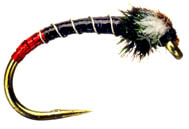Chironomids
Order:
Diptera
Family: Chironomidae
Identifying
Features
Larvae: The body looks like a segmented tube, almost like
a thin worm. Important colors include shades of red, green and brown.
Pupae:
The head, thorax and wing pads are closely clumped together; the thorax
is much larger than during larval stage (contains the wings of the adult).
White tufts (breathing filaments) are visible at the head. The body
remains segmented with no tails. Prominent colors are black, green and
brown.
What
to Look For
As the pupae break through the lake's surface to become adults, they
leave behind an almost transparent husk or shell, called the pupal shuck.
Watch the water carefully for these shucks -- a sure sign midges have
been or are hatching. Bulging surface rises in spring signal fish taking
midge pupae just beneath the surface.
Life
Cycle
Chironomids, or midges, are found in virtually every lake, pond
and tarn in BC. During the larval stage they are bottom dwellers, inhabitating
all zones from shoreline shallows to depths of 70 metres and deeper.
Mass migrations can occur in spring and fall when larvae look for new
homes or move into deeper water to overwinter. The fish respond accordingly.
The pupal stage is heavily preyed upon by trout. Surface migration of
the fully formed pupae is slow and tedious, although trapped air beneath
the pupal shuck helps lift them upward (fish will key to the glint of
the air bubble). At the surface pupae may hang suspended just beneath
the surface film for some time. Finally, the pupal shuck splits along
the back and the adult emerges, taking wing very quickly in search of
a mate. Females return to lay their eggs on the lake's surface; the
eggs sink to the lake bottom and the cycle is repeated. For most species
the entire cycle is completed within one year.
When
to Fish
Immediately after ice-off in the spring, midge pupae begin their journey
to the surface and adulthood. They provide trout with the first real
feast of the year. While there will always be some midges hatching through
the ice- free months, nothing equals the frenzied activity of early
spring. Mid-May to mid-June is peak midge-fishing time.
How
to Fish
Fishing chironomidae pupae sounds like high-tech fly fishing, but is
really not much different from light-line fishing with hook and worm.
Using a floating line and long leader, with the boat anchored bow and
stern, a suitable pupal imitation is cast with the wind. The angler
does nothing more; wind and wave action will normally impart life-like
action to the imitation. If too much wind moves the fly in an unrealistic
manner, find a more sheltered spot to fish. Maintaining a direct link
with the fly is critical: keep the line as straight as possible and
hold the rod tip down, pointed at the water. A strike indicator can
be a big help detecting the characteristic soft take, while also allowing
the fly to be fished at various pre-set depths. Set the hook lightly
by lifting only the rod, leaving the line to run free. The slip strike
is not difficult, but requires practice; the instinct to tightly grip
the line must be overcome.
 |
|
|
Fishing
Tip
During the heat of summer and again in late fall, trout will take
midge larvae on the bottom. In many interior lakes these larvae are
deep red in color because they possess hemoglobin -- the famous "bloodworms"
of the interior lakes. Suitable imitations can be fished near bottom
with sinking lines. Retrieve the line very slowly, a series of two-cm
strips followed by a long pause can be effective. Think of this type
of fishing as a form of meditation.
Be sure
to visit Fishbc.com for angling information!
Back to introduction

















